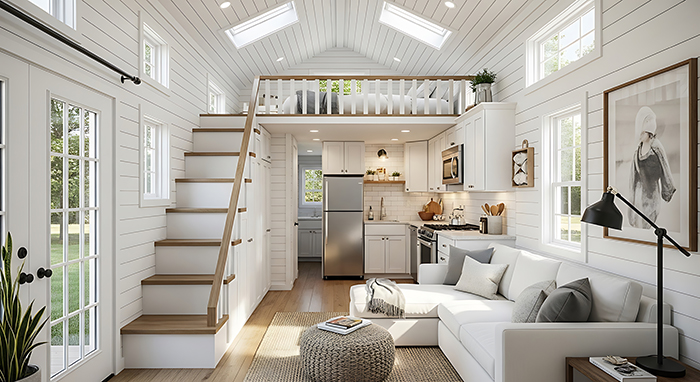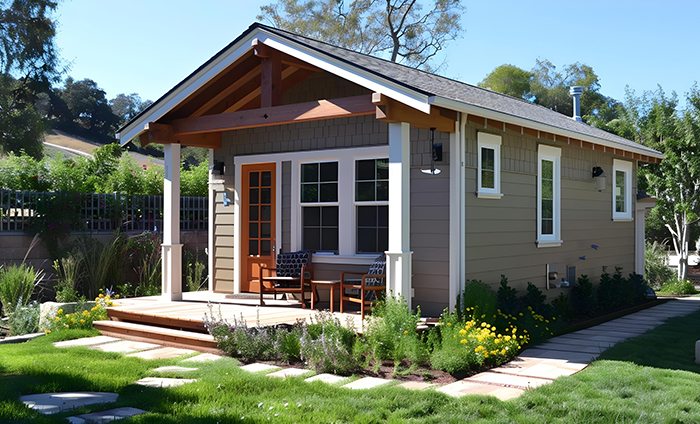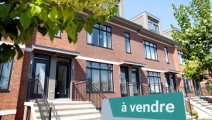Everything you need to know about tiny houses
Have you heard about the tiny house (or tiny home) trend? More than just small houses, tiny houses are part of a lifestyle built around environmental awareness and minimalism. More and more people are choosing tiny houses, as they offer a more affordable way to become a homeowner. If you think this might be a good option for you, here’s our complete guide to buying a home, tiny or not. Read on to find out everything you need to know about tiny houses.

What is a tiny house?
Whether it’s called a tiny house or a tiny home, the concept is the same: a small dwelling, usually no larger than 600 ft2 (about 55 m2).
The concept originated in Japan in the 1990s and, partly spurred by the economic crisis, started gaining popularity in North America in 2007. The idea was simple: to create homes that were more affordable and compact.
Today, the idea hasn’t changed: tiny houses are about reducing costs and make the best possible use of space. Every inch is designed with ingenuity, using built-in storage and multifunctional elements to make even the tiniest spaces fully functional.
Types of tiny houses in Québec
In Québec, tiny houses come in many forms: on wheels, built from shipping containers, elevated, mobile, or even converted from trucks or buses.
Categories of tiny house by size
While the average tiny house is around 600 ft2, there are also subcategories:
- Micro home: under 300 ft2, often on wheels or a trailer, making it easy to move
- Tiny house: between 300 and 600 ft2, often raised on piers, a concrete slab or a foundation
- Small house: between 600 and 1,000 ft2, sometimes with a basement
Any home with more than 1,000 ft2 of living space is considered a regular house. It may not be very large, but it’s no longer classified as a tiny house.
Common types of tiny houses
There are two main types:
- Tiny houses on wheels (usually smaller and easy to move)
- Stationary tiny houses (anchored to the ground and do not move); container homes fall under this second category
|
Tips and tricks
A tiny house on wheels is considered a trailer, which means it needs a licence plate. |
Similar properties
An accessory dwelling unit (ADU) , or UHA in Québec, is similar to a tiny home without necessarily being one .
- Detached accessory dwelling unit: a secondary home built on a lot that already has a main house (often a tiny house)
- Attached accessory dwelling unit: a side annex or an additional floor added to the property
- Interior accessory unit: a living space created within the main house
Here’s a good example of an ADU situation. Let’s say you have elderly parents who are no longer able to live alone. They could move into a tiny house built at the back of your yard . Since there are two separate buildings, this would be considered a multi-generational lifestyle rather than a multi-generational home.
A mobile home is a small dwelling ranging from 600 ft2 to 1,200 ft2. Like a tiny house on wheels, mobile homes can usually be moved and are often located in a private residential park or a cooperative. It’s common for mobile-home-dwellers to rent rather than own the land.
Advantages and disadvantages of living in a tiny house
Living in a tiny house comes with many benefits. But, as with any lifestyle choice, it also presents challenges—especially when it comes to making the most of a very compact space.
Advantages
The biggest advantage of a tiny house is its cost: it’s far more affordable than a standard house.
- Affordable: Ideal for first-time buyers , retirees or anyone looking to reduce their financial obligations. A tiny house frees up money for other pursuits, like travelling or hobbies.
- Simpler living: Minimizing your possessions and embracing simplicity can help you focus on what truly matters. As an alternative to condo living, this lifestyle can also offer more privacy.
- Less maintenance: Smaller spaces naturally require less cleaning and upkeep. This saves you both time and money, which often makes a big difference.
- Lower energy use: Downsizing your living space is an increasingly popular way to shrink your ecological footprint and cut your energy costs. A smaller space requires less heating, cooling and lighting.
- Mobility and flexibility: Tiny houses on wheels can be relocated with relative ease, giving you greater freedom and flexibility. There’s also a fun side to being able to take your home wherever you go.
Challenges and disadvantages
Obviously, one of the main challenges of tiny-house living is the limited space. Not everyone is willing to drastically reduce their possessions to live in such a compact environment.
- Limited space: Living with others in a tiny house can present several challenges, including a lack of space, privacy and storage.
- Restricted locations: Due to local regulations, tiny houses aren’t allowed everywhere. However, the tiny house trend seems to be gaining acceptance. There is a tiny house cooperative in Sherbrooke , different neighbourhoods dedicated to tiny houses (such as in Saint-Joseph-de-Sorel and Shawinigan), and even towns that allow this type of dwelling across their entire territory (such as La Macaza and Lac-des-Écorces).
- Limited return on investment: The value of a tiny house generally increases little, if at all, especially if it’s on wheels. Reselling can therefore be more difficult. However, as demand for this type of housing grows and it becomes increasingly popular, property values could rise.
- Financing: Because tiny houses cost less than standard houses, some financial institutions won’t grant a mortgage. The usual solution is to self-finance using savings or to take out a personal loan. Keep in mind that personal loans are more expensive due to higher interest rates compared with mortgages.

How much does a tiny house cost?
The price of a tiny house varies depending on factors such as whether it’s turnkey, self-built, prefabricated or on wheels.
|
|
|
|
Type of tiny house |
Price |
|
Stationary |
Between $60,000 and $150,000 |
|
Around $40,000 |
|
|
Prefabricated or factory-built |
Between $50,000 and $75,000 |
|
On wheels |
Around $50,000 |
|
Around $25,000 |
|
Note: For prefabricated or factory-built tiny houses, more luxurious models can reach $200,000. There are also kits that include only the basic structure for about $20,000—but note that this is just the shell of the home. You will still need to add the foundation, interior finishes, insulation, electricity, plumbing and more.
These prices are only estimates and depend on many factors.
Factors affecting the cost
The cost of a tiny house is influenced by the same factors as any construction: size, materials, design complexity, land location, etc. On top of that, tiny houses have their own unique considerations: for instance, whether the home is mobile and whether it’s part of a shared community project, which can help split some of the costs.
Tiny houses in Québec and regulations
Since 2018, the Mouvement québécois des Mini-Maisons (MQMM) has been showing that this lifestyle is truly growing in popularity. Their site offers plenty of information, including an interactive map of cities where tiny houses are permitted and information on projects across Québec.
Some municipalities today do allow tiny houses , but there’s still a long way to go. Approval is often handled on a case-by-case basis, meaning future owners need to check with local authorities to find out required building size, foundation type and other specifications. Some regions even have neighbourhoods dedicated to tiny homes, such as Sainte-Marguerite-du-Lac-Masson , Dixville or the municipality of Lantier .
Keep in mind that the process is no different from other construction projects. Regardless of the size of the home, the first step when buying land to build a property is always to check with the city and obtain a permit.
Regulations in Québec
The Québec Construction Code (CCQ) does not apply to dwellings that are less than 700 ft2. This means tiny homes aren’t required to meet certain technical standards, such as for structure, insulation, ventilation or fire safety. This exemption can make construction easier, but it also comes with major risks: some tiny homes may not qualify for home insurance or traditional mortgage financing.
There’s also another important nuance. Even though the CCQ doesn’t apply, provincial regulations set a minimum size for a building to be considered a primary residence (275 ft2 for a studio and 320 ft2 for a one-bedroom home). Tiny houses smaller than this are not treated as permanent residences. This can limit access to permits and municipal services like water and sewer connections. It falls on each municipality to set the zoning rules in its jurisdiction, including the minimum home size for each area and the conditions that must be met.
So, is a tiny home right for you?
Now you know all about tiny homes—what do you think? Could this lifestyle work for you ? One way to find out is to try it: rent a tiny home for a few days and see how it feels!
If you’re ready to make the jump into a smaller space, a good first step could be to start looking for land where you could build your new tiny home.
FAQ
1. Which cities in Québec allow tiny houses?Several municipalities in Québec not only allow tiny houses—they even have dedicated neighbourhoods for them. Examples include Sainte-Luce, New Richmond and Sainte-Rose-du-Nord, as well as many others you can find on the MQMM’s comprehensive tiny house map .
2. Do I need a permit to build or install a tiny house?
As with any construction project, you need to check with the municipality you’re interested in and then apply for a permit.
3. What is the average size of a tiny home?
Tiny houses generally range from 300 to 600 ft2, though they can be up to 1,000 ft2. Beyond that, the house is considered small but not tiny. If the dwelling is under 300 ft2, it is classified as a micro home.

See also:
Is a tiny house right for you?
Tiny houses: a good or bad investment?
What do you know about accessory dwelling units?
 The Largest Number of Homes for Sale
The Largest Number of Homes for Sale



